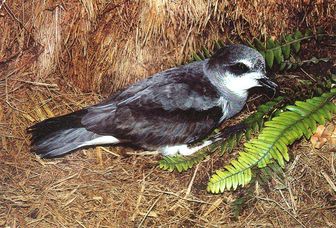Soft-plumaged Petrel
It breeds on islands in the Southern Hemisphere, nesting on Tristan da Cunha, Gough Island, the Prince Edward Islands, Crozet Islands and on the Antipodes Islands of New Zealand. It disperses outside the breeding season, reaching eastern South America north to Brazil, southern Africa and Australia. It has occurred as a vagrant in Israel and Jordan.

Original source: Own work (ZooPro at en.wikipedia)Transferred from en.wikipedia to Commons by User:Innotata using CommonsHelper.
Author: ZooPro at en.wikipedia
Permission: GNU Free Documentation License
The Soft-plumaged Petrel is classified as Least Concern. Does not qualify for a more at risk category. Widespread and abundant taxa are included in this category.
Soft-plumaged Petrel (Pterodroma mollis) photo, In Flight, Off South Georgia, March, 2006 Soft-plumaged Petrel (Pterodroma mollis) photo, In Flight, Off South Georgia, March, 2006 Soft-plumaged Petrel (Pterodroma mollis) photo, In Flight, Off South Georgia, March, 2006 Soft-plumaged Petrel (Pterodroma mollis) photo, In Flight, Off South Georgia, March, 2006 All photos More
The Soft-plumaged Petrel (Pterodroma mollis) is a species of seabird in the Procellariidae family. It breeds on islands in the Southern Hemisphere, nesting on Tristan da Cunha, Gough Island, the Prince Edward Islands, Crozet Islands and on the Antipodes Islands of New Zealand. It disperses outside the breeding season, reaching eastern South America north to Brazil, southern Africa and Australia. It has occurred as a vagrant in Israel and Jordan. Fea's Petrel (P. feae), Deserta's Petrel (P. More
Soft-plumaged Petrel Varanger find of a lifetime I say find but as with any of the best rare bird discoveries this was in fact just a mix of being in the right place at the right time, in effect luck! For everyone who has not seen the article in Birding World a quick summary of this amazing record. More
Soft-plumaged Petrel is relatively straightforward. Firstly, Soft-plumaged Petrels have a complete dark breast band, whereas the bird we sighted had a partial grey breast-band (Figure 1). Secondly, the uppertail coverts of the Soft-plumaged Petrel are dark grey in colour and the tail is rounded in shape, but our bird had whitish coverts and a wedge-shaped tail (Figure 2). These criteria are sufficient to show that the bird was either a Fea More
Soft-plumaged Petrel Pterodroma mollis = * Home Expand Log in Menu item Register Menu item Log out Menu item Change login details Menu item Why register? Expand UK & Ireland Menu item Birding sites More
Soft-plumaged Petrel, Blue Petrels and Fairy Prion (southern) - Conservation issues * 2.1 General Introduction * 2.2 Taxonomy * 2.3 Distribution * 2.4 Population Size and Trend * 2.5 Breeding Biology, Ecology and Diet * 2.6 Threats specific to the Soft-plumaged Petrel, Blue Petrel and Fairy prion (southern) * 2. More
* The taxonomic status of Soft-plumaged Petrels breeding on Maatsuyker Island (and Macquarie Island, should breeding be confirmed) should be established. * All colonies to be protected and managed in such a way that human disturbance is minimised. More
Soft-plumaged petrels were first discovered in the New Zealand region in 1969. In 1978 burrows were located and by 1994 there were several thousand pairs breeding. In the South Atlantic, the Soft-plumaged Petrel is common from 30° to 60°S from the east coast of South America to South Africa. In February, the species has been recorded from 35° to 52°S in the transect from Reunion via Iles Crozet to near Antarctica. More
Soft-plumaged Petrel in contrast, has a darker 'rump', that matches the mantle. This photo also shows the slightly darker tail feathers projecting from under tailcoverts. The tail looks long. The secondaries and inner primaries appear paler than the outer primaries. Figure 2. Fea's Petrel Pterodroma feae, Gulf Stream, North Carolina USA 7/20/96 (photo Copyright More
(1983) The Soft-plumaged Petrel, the Gon-gon and the Freira, Pterodroma mollis, P. feae and P. madeira. Bull. Brit. Ornith. Club 103: 52-58. Enticott, J.W. (1999) Britain and Ireland's first 'Soft-plumaged Petrel' - an historical and personal perspective. British Birds 92: 504-518. Enticott, J.W. (1991) Identification of Soft-plumaged Petrel. British Birds 84: 245-264. Enticott, J. and Tippling, D. (1997) Seabirds of the World: the complete reference. Stackpole Books. Fisher, D. More
Colour/Looks: The Soft-plumaged petrel is mostly dark above and white on the breast and belly. The crown, nape and upper back are usually slate-brown, as is the partial or complete collar around the upper breast. The lores, chin and throat are white. From a distance the underwings look dark, but at close range white highlights can be seen, and the upper wings are marked with a dark M like that of the prions. More
First record of Soft-plumaged Petrels, Pterodroma mollis, breeding in Australia Alan Wiltshire A C, Sheryl Hamilton A and Nigel Brothers B A Nature Conservation Branch, Department of Primary Industries, Water and Environment, GPO Box 44, Hobart, Tas. 7000, Australia. Present address: Department of Conservation, PO Box 29, Te Anau, New Zealand. B PO Box 81, Kettering, Tas. 7155, Australia. C Corresponding author. Email: awiltshire@doc.govt. More

Original source: Peter Ryan
Author: Peter Ryan
Permission: Some rights reserved
Family : Procellariidae
Genus : Pterodroma
Species : mollis
Authority : (Gould, 1844)

